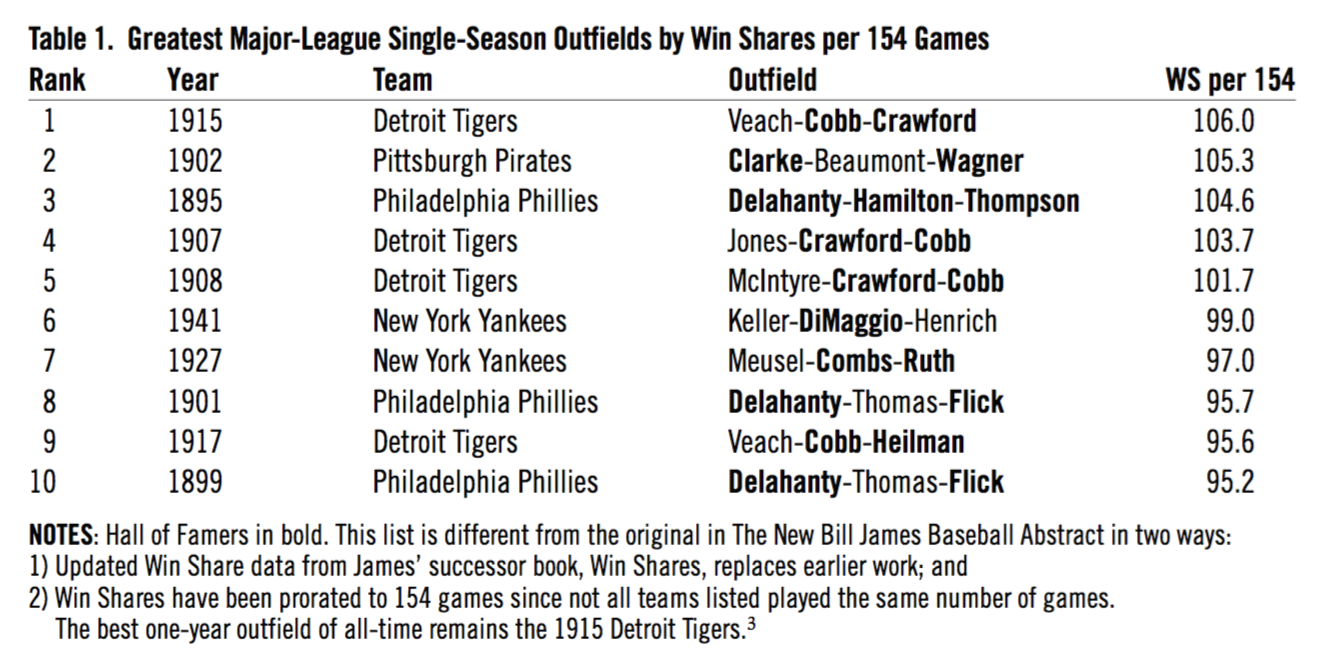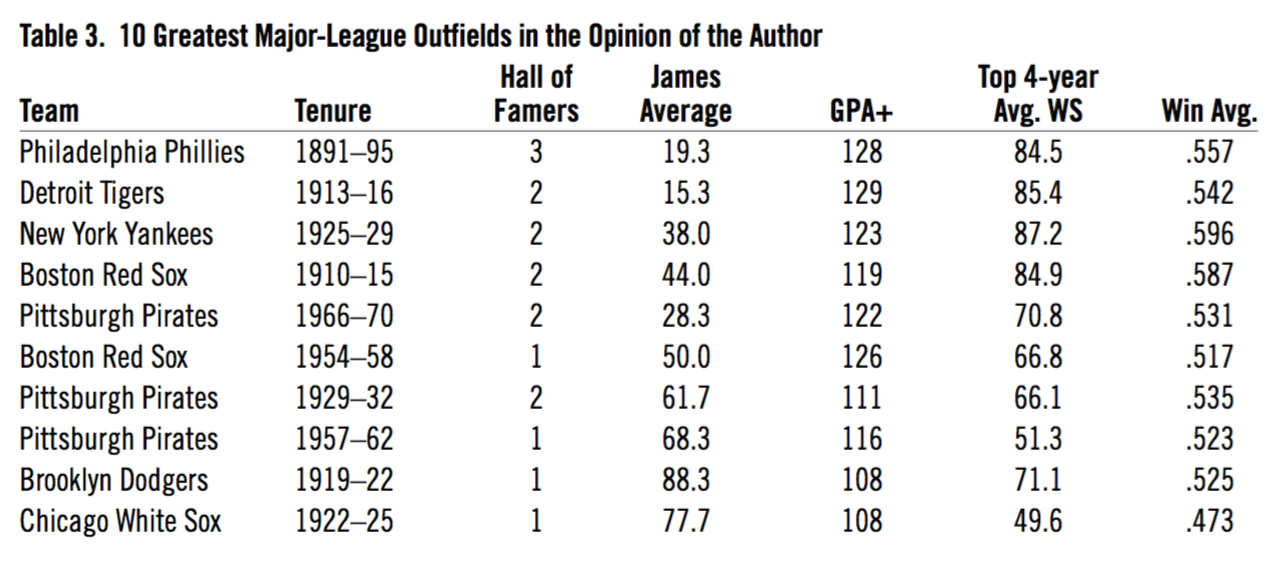The Greatest Outfield in Baseball History
This article was written by Ted Knorr
This article was published in The National Pastime: Steel City Stories (Pittsburgh, 2018)
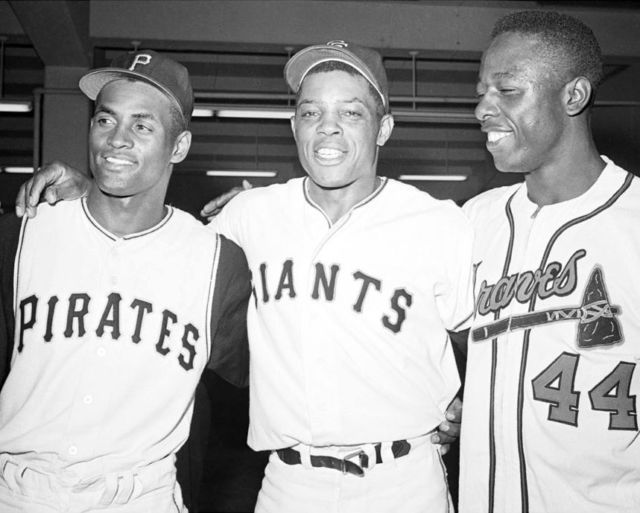
On July 12, 1966, National League All-Star manager Walter Alston wrote out a lineup card with arguably the greatest outfield ever to appear in a baseball game — on any team, in any league, in any era. Leading off was center fielder Willie Mays, batting second was right fielder Roberto Clemente, and hitting third was left fielder Hank Aaron.1 This trio were teammates for just 15 games, all Midsummer Classics, over a 13-year period and they played only 23 innings together as an outfield unit.
It seems reasonable to require greater longevity than 23 innings when trying to identify the greatest outfield in major-league history. Bill James, in his 2001 New Historical Baseball Abstract, offers a list of the 34 greatest single-season outfield units ranked by his then-newly announced statistical tool, Win Shares.2 He concluded that the Detroit Tigers outfield of 1915 was the greatest as their single-season Win Share total was the highest ever. A glance at his top 10 below indicates that James’s methodology had zeroed in on some of the great outfields of all time.
Table 1: Greatest Major-League Single-Season Outfields by Win Shares per 154 Games
(Click image to enlarge)
NOTES: Hall of Famers in bold. This list is different from the original in The New Bill James Baseball Abstract in two ways: 1) updated Win Share data from James’ successor book, Win Shares, replaces earlier work; and 2) Win Shares have been prorated to 154 games since not all teams listed played the same number of games. The best one-year outfield of all-time remains the 1915 Detroit Tigers.3
The full list includes 24 teams (71 percent) from the Segregated Era, 1876–1946 and 10 (29 percent) are from the Integrated Era since 1947. James refers to this “bias,” concluding that baseball was less competitive during earlier eras and player performance of the greats was further removed from average than they are now. Between a third and a half of qualified players were not permitted in the major leagues because of segregation, lowering overall quality and expanding the difference between great and average. Despite this qualifier, James notes that the list indeed does identify many of the expected outfields. This is underscored when one notes that 13 of his 34 are anchored by one of the first three outfielders elected to the Hall of Fame in 1936 and ’37: There are seven outfields with Ty Cobb, four with Babe Ruth, and two with Tris Speaker. An additional three outfields include Ed Delahanty from a turn-of-the-century Philadelphia Phillies outfield.
In ranking outfields, once a single-season best is determined, the next question is how many seasons should be required by an intact outfield to be considered the best of all-time. Before answering that question, using the James list, I calculated the best two- and three-year outfields using the same Win Shares system. In addition, my prior research had found only 17 four-year intact outfields, 10 that lasted five years, and two six-year outfields to which it was easy to apply the same Win Share per 154-game methodology. Shockingly, all six categories—outfields that stayed together for one, two, three, four, five, and six years—are led by trios anchored by Cobb, Ruth, Speaker, or Delahanty.
Table 2: Greatest Major-League Outfields in Consecutive Seasons by Win Shares
(Click image to enlarge)
* Table 2 simply adds Win Shares for each season.4 However, the Phillies of 1891–95 only played an average of 135 games per season. Extrapolated to 154-game seasons, the Phillies’ outfield (Delahanty-Hamilton-Thompson) of that span had more Win Shares per 154 games for two, three, four, and five consecutive seasons (all ending in 1895) than any other team in baseball history.
I think it is fair to require an outfield to remain intact for four years and contain at least one Hall of Famer to be considered the best. I have been able to identify 17 outfields intact for a four-year period, of which 10 included at least one Hall of Famer.5 The below list then may not be the 10 best but it is my strong feeling that the best outfield in major-league history is surely on the list. The table includes: franchise; tenure; number of Hall of Famers, Bill James average rank of the outfielders (e.g. in the case of the Phillies, James, in his New Historical Abstract, offers Delahanty as the 12th-best left fielder, Hamilton the ninth-best center fielder, and Thompson the 37th-best right fielder for an average of 19.3); Gross Production Average Plus (a refinement of OPS+ where on base percentage is weighted at 1.8 times slugging percentage); average Win Shares per 154 games over the outfield’s best four-year run; and the team’s winning average over the duration of that run.6 The list is in composite order weighing the six factors equally.
Table 3: 10 Greatest Major-League Outfields in the Opinion of the Author
(Click image to enlarge)
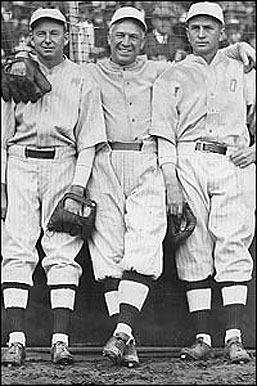
I have no problem declaring any of the top four outfields listed above as the greatest major-league outfield of all-time. But the title of this article is “The Greatest Outfield” not the greatest major-league outfield. I truly feel the best baseball ever played is being played today, in 2018, and, if not today, definitely since the integration of MLB began on April 15, 1947. However, in addition to the statistical bias James points out, other factors, such as expansion, platooning, free agency, higher salaries, designated hitters, and disabled lists, make it difficult for an outfield to remain intact for four years. Not to mention the influx of talent due to the integration of the game, which had the opposite effect of the bias James noted in that the abundance of talent increases competition and narrows the gap between the greats and the average. Consider that of the 41 Hall of Fame outfielders beginning their major-league careers during segregation, zero are black or Latino (with the unrecognized, at the time, exception of Ted Williams), while 18 of the 23 Hall of Fame outfielders beginning careers since integration would not have been permitted to play in the earlier era. I think before pronouncing those Phillies, Tigers, Yankees, or Red Sox outfields as the best, we must examine the Negro Leagues.
Fortunately, the Baseball Hall of Fame has done the heavy lifting. There are seven Negro League outfielders in the Hall and five more who were on the final 2006 ballot; meaning that the dozen best Negro League outfielders in the opinion of the National Baseball Hall of Fame have been identified.7 There is only one outfield that includes three of the dozen as regulars during their primes: the Harrisburg Giants, featuring Fats Jenkins, Hall of Famer Oscar Charleston, and Rap Dixon. Further, the outfield was intact for four years, except when right fielder Dixon was in Japan for the beginning of the fourth season.
Here is what the Harrisburg Giants’ line would have looked like in Table 3:8
Table 4: Harrisburg Giants Outfield with Same Criteria as Table 3
(Click image to enlarge)
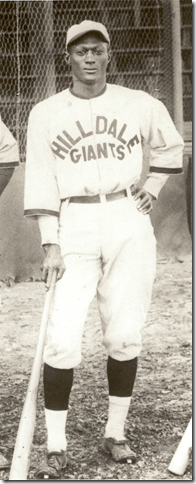 In the Historical Abstract James ranks Negro League outfielders by position, with left fielder Jenkins eighth and Charleston first among center fielders and Dixon ninth among right fielders. This outfield thus averages 6.0 per position and is the best among all Negro League outfields. In Table 4 I refer to this as NA until I adjust this number to, in my opinion, an average ranking among the 10 best four-year outfields in major-league history.
In the Historical Abstract James ranks Negro League outfielders by position, with left fielder Jenkins eighth and Charleston first among center fielders and Dixon ninth among right fielders. This outfield thus averages 6.0 per position and is the best among all Negro League outfields. In Table 4 I refer to this as NA until I adjust this number to, in my opinion, an average ranking among the 10 best four-year outfields in major-league history.
The line shown in Table 4 would place them sixth in Table 3. However, when you consider the achievement of outfielders since integration by players who would not have been permitted to play during the Segregated Era, I think one could read the 6.0 James average as at least equal to the average such rank among the 10 outfields in Table 3. Further, given that 78 percent of Hall of Fame outfielders who began their careers during the Integrated Era would have been Negro Leaguers prior to integration, and that only 15 percent of pre-integration outfielders in the Hall of Fame are from the Negro Leagues, it is reasonable to see the five Negro League outfielders who were left out in the 2006 Hall of Fame balloting are deserving Hall of Famers. Those two adjustments bring the rank of the Harrisburg Giants to second, behind the Phillies. If one uses a timeline adjustment in calculating Win Shares, the Harrisburg outfield moves to the top of the list. I do not presume to think that I have objectively proven my case, but I do feel that I have demonstrated sound logic for my opinion.
Here’s that Harrisburg Giants’ line again, adjusted for the assumptions in the previous paragraph:
Table 5: Harrisburg Giants Outfield After Adjustments Described Above
(Click image to enlarge)
To close, I want to briefly introduce my choice for the Greatest Outfield of all-time, the 1924–27 Harrisburg Giants.
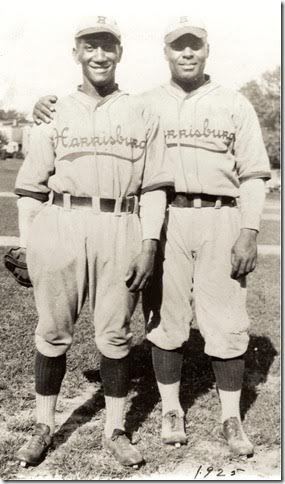 In left field, Fats Jenkins: Buck Leonard includes Jenkins as left fielder on his all-time nine and ranks him as the most deserving of induction into the Hall of Fame among the five outfielders remaining on the 2006 ballot.9 Jenkins was named to the 1952 Pittsburgh Courier Poll Honor Roll.10 Only Jackie Robinson was inducted into any of the four North American professional team sport Halls of Fame prior to Jenkins, who went into the Naismith Memorial Basketball Hall of Fame in 1963 with his teammates from the 1939 New York Renaissance. Jenkins was captain of the team that won the first professional basketball world championship.11
In left field, Fats Jenkins: Buck Leonard includes Jenkins as left fielder on his all-time nine and ranks him as the most deserving of induction into the Hall of Fame among the five outfielders remaining on the 2006 ballot.9 Jenkins was named to the 1952 Pittsburgh Courier Poll Honor Roll.10 Only Jackie Robinson was inducted into any of the four North American professional team sport Halls of Fame prior to Jenkins, who went into the Naismith Memorial Basketball Hall of Fame in 1963 with his teammates from the 1939 New York Renaissance. Jenkins was captain of the team that won the first professional basketball world championship.11
Fats Jenkins, Seamheads Statistics: .328/.399/.417, 118 OPS+.12
Hall of Fame ballot, 2006.
In center field is the incomparable Oscar Charleston: He was ranked by Bill James as the greatest of the Negro League players behind only Ruth, Wagner, and Mays among 20,000 major-league-equivalent baseball players.13 Charleston was second to Josh Gibson in the 1952 Pittsburgh Courier poll and the second deceased Negro Leaguer, behind Gibson, inducted into the National Baseball Hall of Fame.14 He led all Negro Leaguers in singles, doubles, triples, home runs, runs, RBIs, steals, and walks, and was in the top six in on-base percentage, OPS, and OPS+.15
Oscar Charleston, Seamheads Statistics: .350/.428/.571, 179 OPS+.16
Hall of Fame, 1976.
Last, my favorite, the right fielder, Rap Dixon: He was listed on the all-time Negro Leagues team by Hall of Famers Cool Papa Bell and Leon Day; player Jake Stephens; executives Lloyd Thompson and Bill Powell; writers Al Moses and Claude Carmichael; and researchers Lou Hunsinger and me.17 In addition, Larry Doby and Monte Irvin both rank Dixon as the most deserving of induction into the Hall of Fame among the five outfielders who were left out from the 2006 ballot.18 Charleston told the Philadelphia Evening Bulletin in 1949 that Dixon was the greatest African-American outfielder he ever saw.19 Dixon still holds the major-league-equivalent record for consecutive base hits with 14 in 1929; hit the first home run by a Negro Leaguer in Yankee Stadium in 1930; along with Gibson replaced Johnny Mize on the 1934 Concordia Eagles Winter League team, sparking them to the Caribbean title; and managed an integrated minor Negro League team in 1942.20 I know of no Negro Leagues player who isn’t in the Hall of Fame who had more Hall of Fame teammates than Dixon.
Rap Dixon, Seamheads Statistics: .322/.400/.531, 146 OPS+.21
Hall of Fame ballot, 2006.
I consider this Harrisburg Giants outfield, the best in Negro Leagues history, the best outfield to ever play the game of baseball on any team, in any league or era. I appreciate the opportunity to present my feeling to you and I hope that you will give some consideration to my point of view and look at this great outfield anchored by Oscar Charleston as comparable to those led by Ty Cobb, Babe Ruth, Tris Speaker, and that marvelous three-Hall of Famer outfield from Philadelphia in the 1890s.
TED KNORR has been a baseball fan since infancy, when his grandma gave him a Brooklyn Dodgers jersey. A few years later, an aunt introduced him to baseball via Ladies Nights at Forbes Field. Later still, a childhood friend — Martha— introduced him to the APBA Major League Baseball Game. Ted has been a SABR member since 1979 and, in 1998, founded and hosted the initial Jerry Malloy Negro League Research Conference. This is his first article for The National Pastime.
Notes
1 “1966 All-Star Game Box Score,” Baseball-Reference.com, https://www.baseball-reference.com/allstar/1966-allstar-game.shtml.
2 Bill James, The New Bill James Historical Baseball Abstract, (New York: The Free Press, 2001), 673–76.
3 Bill James and Jim Henzler, Win Shares, (Chicago: Stats Publishing, 2002).
4 James and Henzler.
5 I’ve been collecting four-year outfields for the past 20 years and have been influenced/assisted by the work of Bill Gilbert, Jerrold Casway, and Robert Tracy, who was particularly helpful in confirming the 17 that I count as being the only major-league outfields intact four or more years.
6 James, New Historical Abstract; James and Henzler, Win Shares; Lee Sinins, Complete Baseball Encyclopedia, http://www.baseball-encyclopedia.com/.
7 2006 Special Committee on the Negro Leagues Election, Baseball-Reference.com, https://www.baseball-reference.com/bullpen/2006_Special_Committee_on_the_Negro_Leagues_Election. The seven Negro Leagues outfielders in the Hall of Fame are Monte Irvin, Cool Papa Bell, Oscar Charleston, Turkey Stearnes, Pete Hill, Cristobal Torriente, and Willard Brown. The five who were on the 2006 ballot who didn’t make it in, logically the eighth- through 12th-best outfielders in Negro Leagues history in the Hall of Fame’s view, are Rap Dixon, Fats Jenkins, Spottswood Poles, Alejandro Oms, and Roy Parnell.
8 James, The New Bill James Historical Abstract, 187–92; Robert Peterson, Only the Ball Was White, (Old Tappan, NJ: Prentice-Hall, 1970); “Negro Leagues Database,” Seamheads, http://www.seamheads.com/NegroLgs/; Harrisburg Giants GPA+ was calculated by the author using statistics found at Seamheads.com, supplemented for 1927 with statistics developed by the Negro Leagues/Researchers & Authors Group, 2001–06, and contained in the February 27, 2006, Hall of Fame press release. GPA is a refinement of OPS, where OBP is weighted 1.8 times SLG. GPA+ is GPA/league GPA. Win Shares for the Harrisburg outfield are from Seamheads.com except for 1927, which do not yet exist and have been conservatively estimated by the author. The WS for the ’24–27 period is prorated to 154 games for each of the four consecutive years. Harrisburg seasonal won-loss record is taken from Seamheads.com for 1924–26 and for 1927 from Peterson, Only the Ball Was White.
9 William F. McNeil, Cool Papas and Double Duties, (Jefferson, NC: McFarland, 2001), 157.
10 “Courier Experts’ Roll of Honor,” Pittsburgh Courier, April 19, 1952.
11 “New York Renaissance,” Naismith Memorial Basketball Hall of Fame, http://www.hoophall.com/hall-of-famers/new-york-renaissance.
12 “Fats Jenkins,” Seamheads Negro Leagues Database, http://seamheads.com/NegroLgs/player.php?playerID=jenki01fat.
13 James, New Historical Abstract, 358. James ranks Cobb fifth, behind Charleston.
14 “Courier Experts’ Roll of Honor.”
15 “Batting,” Seamheads Negro Leagues Database, http://seamheads.com/NegroLgs/history.php?tab=bat_basic_at.
16 “Oscar Charleston,” Seamheads Negro Leagues Database, http://seamheads.com/NegroLgs/player.php?playerID=charl01osc.
17 Larry Lester, Black Baseball’s National Showcase (Lincoln: University of Nebraska, 2001); NcNeil, Cool Papas and Double Duties; Chester Washington, “Sez Ches: The Scintillating Stevens Selects An All-Time All-Star Team,” Pittsburgh Courier, January 30, 1943; “Courier Experts’ Roll of Honor,” Pittsburgh Courier, April 19, 1952; Negro Baseball Pictorial Year Book (Washington, DC: Sepia Sports, 1945)
18 McNeil, Cool Papas and Double Duties.
19 Dick Clark & Larry Lester, eds., The Negro Leagues Book (Cooperstown, NY: SABR, 1994), 37.
20 Baltimore Afro American, August 3, 1929; William G. Nunn, “Diamond Stars Rise to Miracle Heights in Big Game at Yankee Bowl,” Pittsburgh Courier, July 12, 1930; Concordia Golden Eagles 1934 Team Photo, https://www.hakes.com/Auction/ItemDetail/72452/CONCORDIA-EAGLES-1934-TEAM-PHOTO-WMARTIN-DIHIGO-JOSH-GIBSON, featuring Hall of Famers Martin Dihigo and Josh Gibson and greats like Tetelo Vargas, Luis Aparicio Sr, and Rap Dixon, who is by himself in the middle; “Daisies Play Harrisburg Giants 2 Games,” Philadelphia Tribune, August 22, 1942.
21 “Rap Dixon,” Seamheads Negro Leagues Database, http://seamheads.com/NegroLgs/player.php?playerID=dixon01rap.



